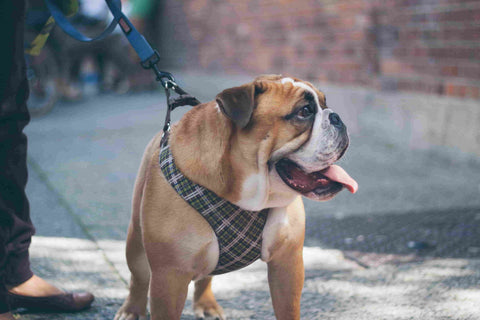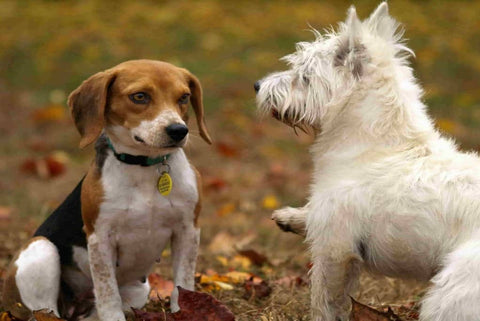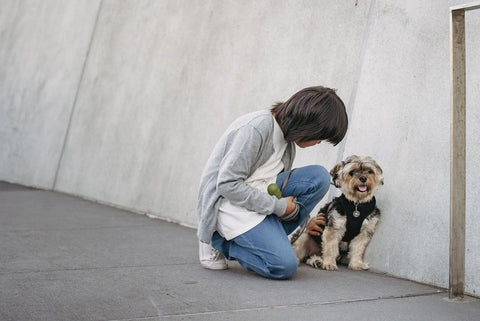What is a Dog Chest Harness?
Is your dog’s collar no longer working for you? Are you searching for something better?
There are alternatives to a traditional dog collar that can provide more safety, comfort, and functionality. A dog chest harness is the best option overall.
Using a dog chest harness offers more control for you, and you can more easily manage your dog, even if he’s not fully trained yet. Harnesses are easier on your back and arms, they discourage pulling and they’re much safer than options like a conventional collar or a choke collar.
Unlike a collar, a chest harness disperses pressure from the leash all over your dog’s body, rather than concentrating it at one point. A dog chest harness has a wide band and adjustable straps as well.
So what else should you know about using dog harnesses? We compiled key details below, as well as some of the things you should know when you make a buying decision.
Benefits of Using a Chest Harness
At Pet&Cuddle, we use our expertise in dog gear to help owners find the best products for their pets every day. We encourage you to explore the benefits of using a chest harness. These include:
- Control: When you go on walks, you want to feel like you’re in control. This is especially true if your dog is very big or heavy, tends to lunge or pull, or you often walk in places where there are a lot of cars or other people and animals. Harnesses offer a high level of control because of the additional attachment options they feature and the pressure points that are spread around your dog’s body. Control can equate to a safer, more pleasant walk for you and your dog.
- Training: If your dog isn’t well-trained, harnesses are good tools to facilitate that. No-pull harnesses help your dog learn how to walk appropriately. Most professional trainers recommend using a chest harness to teach against destructive walking behaviors.
- Safety: The pressure that a collar puts right at your dog’s throat and neck can lead to discomfort and even injuries, which is avoided with the use of a harness. It’s also tougher to escape from a harness than it is from a collar.
- Comfort: If your dog is wearing a harness, once he gets used to it, you’ll notice he seems more comfortable. When paired with a retractable leash, a harness offers you the functionality and flexibility to do any activity with ease.
The Difference Between a Chest Harness and a Collar
Collars cause constriction, discomfort, and even choking, especially when a dog isn’t trained yet and pulls on walks. Dog harnesses help with training without any of these dangerous downsides. When you’re walking your dog with a collar, it creates a risk of neck injury. If your dog has respiratory problems, which is common with breeds like French Bulldogs, the restriction of a collar can be even more dangerous and may lead to tracheal collapse.
Your dog can also slip out of a collar and escape.
With chest harnesses, on the other hand, you can teach your dog how to walk on a leash in a positive way and you can stop him from pulling or jumping without choking. You’re less likely to get tangled up with the leash when you use a harness, and you don’t have to constantly worry about your dog escaping, especially if he’s a breed with a slim neck and head.
Features to Look for in a Right Dog Harness
Keeping in mind the following features can help you choose the best dog harness for any activity, including leisurely walks as well as training.
- Safety: A safe design is the biggest priority. There is an inherent element of security in the design of harnesses. Make sure that the chest harness you choose is going to evenly distribute any pressure and won’t cause discomfort. For example, think about selecting an option that has padded straps.
- Easy to use: Don’t choose a harness that’s overly complicated for you. It’s ideal to be able to put it on and take it off quickly, encouraging you to go on more frequent walks.
- Adjustability: Adjustable belts let you customize the fit of the dog harness for comfort and safety. An adjustable harness can also grow with your dog a bit, so you’ll get years of use out of it.
- Weight: Choose an ergonomic and lightweight design that’s easy to take on the go.
- Clip location: Most harness designs feature one of three options. There’s a front clip, a back clip, or a dual clip with both. Dual clip harnesses give you more flexibility.
- Reflective straps: Do you love walking in the early morning before the world wakes up, or maybe at night, once things are settling down? If so, don’t forget to choose a harness with reflective details for safety.
- Material: A nice, soft material will feel great for your dog. One of our favorite materials is nylon with added padding. Nylon’s both durable and protects your dog’s skin and fur.
How to Choose the Right Harness for Your Dog
Remember a few things when you’re choosing the best harness for your dog. Specifically, keep in mind size, material, and function. We created everything you need to know in the step-by-step guide below.
Step 1. Choose the Harness Type
There are a few major categories of harnesses to choose from, based on clip location as well as design.
Step-In Dog HarnessWith a step-in dog harness, you have your dog stand over it, and then you bring it up to meet at their back so you can fasten it. If your dog doesn’t like things going over its head or you struggle with putting other types of harnesses on, consider a step-in option. Step-in harnesses form triangles at the legs rather than rectangles.
Whether you go with a step-in design or one that goes over the head is really a matter of preference.
Back Clip Dog Harness
A back clip dog harness features the D-ring for the leash attachment point at the top back. This is the most comfortable for your dog, and it’s good if he’s well-trained and doesn’t tend to pull, jump or lunge.
The back clip gives some freedom and is also suitable if you’re walking in an open area. You do have less control over your dog if you’re using a back clip harness.
Front Clip Dog Harness
When the leash attachment point is at your dog’s chest, it’s a front clip harness. When your dog is still training, you might opt to use this because there’s a bit of tension that’s generated if your dog tries to pull. It creates a sensation in the shoulder blades that can discourage pulling or bad walking behaviors.
If you’re somewhere that you need a lot of control, you might also want a front clip.
Dual Clip Dog Harness
Ideally, choose a dual clip harness because you get the benefits of both a front and top clip. You can switch your leash to whichever attachment you need at the time.
Step 2. Get the Right Size
If you get the wrong size harness, it creates a risk of injury and escape. Pay attention to size options carefully, and we recommend that you always measure your dog first. Don’t rely on weight alone or the breed of your dog.
Follow the steps below to get your dog’s exact measurements:
Step One: Get a soft measuring tape. If you don’t have one, you can use something like string and a ruler. Whatever you use should be easily wrapped around your dog.
Step Two: You may need someone to help you here. Get your dog to stand on all fours with a straight back. Keep him as still as you can.
Step Three: Now, measure your dog’s lower neck, where it meets his chest. This should be the widest point of the neck. Wrap your tape measure around it snugly but not super tight. Don’t measure too high on the neck because this is where a collar is typically worn as opposed to a harness.
Step Four: After you get the neck circumference, measure your dog’s chest. Using your tape measure, wrap it around the widest part that’s right behind his front legs. Again, it should be snug but not too tight.
Step Five: Depending on how you want it to fit, you might also want a harness that will cover your dog’s midsection. In order to get this measurement, start a line right behind the front legs, and then take the tape measure to the point directly in front of the back legs.
Step Six: Redo your measurements one more time to ensure you got them right, and then head to Pet&Cuddle to check our size charts. If your dog is between two sizes on the chart, go up and get the bigger option.
Step 3. Select the Design You Like from Pet&Cuddle
As was touched on above, once you get your dog’s measurements, you can start the fun part, which is shopping our selection of the best harnesses.
There are various designs for dog chest harnesses on our website, so if you are ready to pick up your first harness for a dog or choose the new one from our latest collection - just tap here.
Our team has launched the newest collection of chest harnesses for dogs, which are safe, comfortable, easy to wear, and will accompany you and your pet during the happiest moments of your time spent together.
Step 4. Adjust for Proper Fit
Once you’ve selected your dog’s harness and it arrives, put it on him and adjust the straps. You should be able to fit any two fingers under any strap comfortably, but it should still be a tight fit. Try to pull the harness over your dog’s head, which you should not be able to do if the fit is correct.
Tips for Getting Your Dog Used to Wearing a Chest Harness
Dogs may adjust to learn new skills or get used to doing certain things, including wearing a chest harness. This is particularly true if your dog is used to a collar.
You can work with your dog and gradually introduce a harness so he learns it’s not something to be afraid of. It’s an adaptation process, and once your dog understands the routine, he’ll be excited when he sees the harness come out, and he knows it’s time to go for a walk.
1.) When you’re first getting your dog acclimated to a harness, it’s a good idea to take it and let him play with it for a bit. Don’t try to put it on him right away. Let him sniff it and familiarize himself with it.
2.) Take the chest harness with you if you’re heading out for a walk, and carry it so that your dog can see it during this time. He’ll start to associate with his walks and playtime.
3.) Let your dog adjust to wearing the harness while you’re still at home. Maybe, for example, he wears it around the house for a few minutes.
4.) Progress to walking in a harness, but only when you feel your dog is ready. Remember to be patient. If you rush it, your dog will start to dread or fear the harness. If you take your time, it’ll become an ingrained part of your routine.
The Importance of Getting the Right Harness for Your Dog
The right dog chest harness is a perfect choice for pet parents who care about their dog's safety and comfort. A dog harness has a lot of benefits in comparison to a traditional collar and is widely used for the activities like training, walking, and running with your dog.
So, if you have decided to pick one - our Pet&Cuddle team would love to help you pick up one that fits your dog best! We have processed all the knowledge and practical experiences to create the perfect dog harness with a unique design.
Comfortable and safe, it now can be easily used for many purposes like training, walking, or adapting to a leash. Discover the latest products for dogs available on our website!
Questions About Dog Harnesses
If you’re entirely new to dog harnesses, you likely have some questions. We love answering questions because we’re passionate about helping you and your dog. Below are answers to some of the questions we get most frequently.
Are Dog Chest Harnesses Safe?
Not only are dog chest harnesses safe on their own, but they’re safer than collars. A collar puts a lot of pressure right on a dog’s neck and throat. That can lead to tracheal injuries or choking. Some people even use choke collars as a training tool, yet they can be dangerous and painful. A chest harness is a much safer, more comfortable, and also more effective way to train a dog.
Dogs that have respiratory problems are at an even greater risk of being hurt by a collar, so we encourage you to think about these factors.
Can I Use a Dog Chest Harness for a Puppy?
If you have a puppy, talk to your vet and get their recommendation about when a good time to start using a chest harness is. Most vets recommend you wait until your puppy is around eight months old, and then it’s considered safe to use one. Just make sure that you get the right size.
When Should I Use a Dog Harness?
What’s excellent about dog harnesses is their versatility. They’re good across so many situations. For example, you can use them to walk in crowded places but also open areas. They’re suitable for a quick walk around the block or a long hike. You can go jogging, to the dog park, or to a dog-friendly patio and the harness is going to work well in all these scenarios.
Should I Use a Retractable Leash with a Dog Chest Harness?
At Pet&Cuddle, we really prefer the use of retractable leashes. They’re safe and they let you adjust your walking experience accordingly. For example, in an open park or space, you can give your dog the freedom and independence to roam. When you’re in a crowded area or need more control, you can reel the leash in.
Some people are afraid to use a retractable leash with a chest harness, but they shouldn’t be. The two are safe to use together. The only thing to remember is that you shouldn’t let the leash line generate any tension if it’s hooked to the front clip of a harness. This can confuse your dog and make him think he’s pulling even if he’s not. Beyond that, yes, you can use a retractable leash and dog chest harness together.
Can I Leave the Harness on My Dog All Day?
A harness shouldn’t be left on your dog all day. There’s no purpose in doing so, and it can be uncomfortable when it’s constantly rubbing against your dog’s skin or fur. Instead, as part of acclimating your dog to the harness, make it a routine. When you get the harness out, your dog knows it’s time to go out. Then, take it off when you get home and put it in the same location it came from.
Get the Perfect Dog Harness from Pet&Cuddle!
Learning more about the critical features of a dog harness and how to fit it properly will save you time and make your walks great!
We, the dog lovers from Pet&Cuddle, having deep knowledge and practical experiences, created the perfect harnesses with a unique design for your dog. Comfortable and safe, it now can be easily used for many purposes like training, walking, or adapting to a leash.
Discover the latest products for dogs available right here!




